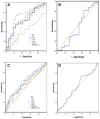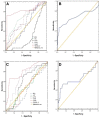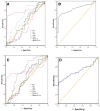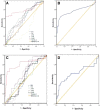Prediction of metabolic syndrome among postmenopausal Ghanaian women using obesity and atherogenic markers
- PMID: 22883105
- PMCID: PMC3479426
- DOI: 10.1186/1476-511X-11-101
Prediction of metabolic syndrome among postmenopausal Ghanaian women using obesity and atherogenic markers
Abstract
Background: Metabolic syndrome (MetS) is an important health problem which puts individuals at risk for cardiovascular diseases and type 2 diabetes as well as obesity-related cancers such as colon and renal cell in men, and endometrial and oesophageal in women.
Objective: This study was aimed at examining how obesity indicators and related determinants influence metabolic syndrome, and how the factors can be used to predict the syndrome and its cut-offs in postmenopausal Ghanaian women.
Methods: Two hundred and fifty (250) Ghanaian subjects were involved in the study with one hundred and forty-three (143) being premenopausal women and one hundred and seven (107) postmenopausal women. The influence of traditional metabolic risk factors including high blood pressure, dyslipidemia and glucose intolerance on obesity and atherogenic indices i.e. body mass index (BMI), waist circumference (WC), waist-to-hip ratio (WHR), Waist-to-thigh ratio (WTR), waist-to-height ratio (WHtR), high density lipoprotein cholesterol to total cholesterol ratio (HDL-C/TC), high density lipoprotein cholesterol to low density lipoprotein ratio (HDL-C/LDL-C) and triglyceride to high density lipoprotein cholesterol ratio (TG/HDL-C) were identified according to the Harmonization (H_MS) criterion.
Results: The predominant anthropometric marker that significantly influence metabolic risk factors among the pre- and postmenopausal women was waist-to-hip ratio (premenopausal: p- 0.004, 0.026 and 0.002 for systolic blood pressure (SBP), fasting blood glucose (FBG) and HDL-C; postmenopausal: p-0.012, 0.048, 0.007 and 0.0061 for diastolic blood pressure (DBP), FBG, triglyceride (TG) and high density lipoprotein cholesterol (HDL-C) respectively). Using the receiver operating characteristic (ROC) analysis, the area under the curve for WC, WHR, TG/HDL-C and HDL-C/TC among postmenopausal women were estimated at 0.6, 0.6, 0.8 and 0.8 respectively. The appropriate cut-off values for WC, WHR, TG/HDL-C and HDL-C/TC that predicted the presence of metabolic syndrome were 80.5 cm, 0.84, 0.61 and 0.34 respectively.
Conclusion: The presence of metabolic syndrome among Ghanaian postmenopausal women can be predicted using WC, WHR, TG/HDL-C and HDL-C/TC.
Figures




Similar articles
-
Optimal cut-off for obesity and markers of metabolic syndrome for Ethiopian adults.Nutr J. 2018 Nov 22;17(1):109. doi: 10.1186/s12937-018-0416-0. Nutr J. 2018. PMID: 30466421 Free PMC article.
-
Waist-to-Height Ratio and Triglycerides/High-Density Lipoprotein Cholesterol Were the Optimal Predictors of Metabolic Syndrome in Uighur Men and Women in Xinjiang, China.Metab Syndr Relat Disord. 2015 Jun;13(5):214-20. doi: 10.1089/met.2014.0146. Epub 2015 Mar 17. Metab Syndr Relat Disord. 2015. PMID: 25781351
-
The most appropriate cut-off point of anthropometric indices in predicting the incidence of metabolic syndrome and its components.Diabetes Metab Syndr. 2019 Jul-Aug;13(4):2739-2745. doi: 10.1016/j.dsx.2019.07.009. Epub 2019 Jul 16. Diabetes Metab Syndr. 2019. PMID: 31405702
-
Cardiometabolic and obesity risk outcomes of dawn-to-dusk, dry intermittent fasting: Insights from an umbrella review.Clin Nutr ESPEN. 2025 Jun;67:127-145. doi: 10.1016/j.clnesp.2025.03.006. Epub 2025 Mar 11. Clin Nutr ESPEN. 2025. PMID: 40081802
-
Metabolic Syndrome Features: Is There a Modulation Role by Mineral Water Consumption? A Review.Nutrients. 2019 May 22;11(5):1141. doi: 10.3390/nu11051141. Nutrients. 2019. PMID: 31121885 Free PMC article. Review.
Cited by
-
The prevalence of metabolic syndrome and its predominant components among pre-and postmenopausal Ghanaian women.BMC Res Notes. 2013 Nov 8;6:446. doi: 10.1186/1756-0500-6-446. BMC Res Notes. 2013. PMID: 24206898 Free PMC article.
-
Obesity and Associated Cardiometabolic Risk among Women from Tripura - A Northeastern State of India.J Midlife Health. 2017 Jul-Sep;8(3):110-117. doi: 10.4103/jmh.JMH_116_15. J Midlife Health. 2017. PMID: 28983157 Free PMC article.
-
Rice Bran Supplementation Ameliorates Gut Dysbiosis and Muscle Atrophy in Ovariectomized Mice Fed with a High-Fat Diet.Nutrients. 2023 Aug 9;15(16):3514. doi: 10.3390/nu15163514. Nutrients. 2023. PMID: 37630706 Free PMC article.
-
The metabolic syndrome among postmenopausal women in rural Canton: prevalence, associated factors, and the optimal obesity and atherogenic indices.PLoS One. 2013 Sep 9;8(9):e74121. doi: 10.1371/journal.pone.0074121. eCollection 2013. PLoS One. 2013. PMID: 24040183 Free PMC article.
-
Prevalence of the metabolic syndrome in African populations: A systematic review and meta-analysis.PLoS One. 2023 Jul 27;18(7):e0289155. doi: 10.1371/journal.pone.0289155. eCollection 2023. PLoS One. 2023. PMID: 37498832 Free PMC article.
References
-
- Funahashi T, Matsuzawa Y, Kihara S. Adiponectin as a potential key player in metabolic syndrome. Insights into atherosclerosis, diabetes and cancer. Int Congr Ser. 2004;1262:368–371.
-
- Paszkowski T, Kłodnicka M. Hormonal Therapy of menopause. Menopause. 2007;2:106–109.
MeSH terms
Substances
LinkOut - more resources
Full Text Sources
Medical
Miscellaneous

